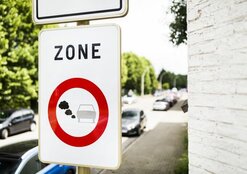As part of the Wallonia Environment-Health Plan, the ISSeP has been charged with estimating the environmental impact of the introduction of municipal low emission zones by combining in situ pollutant concentration measurements with air quality modelling on a municipal scale. The municipalities of Namur and Eupen have acted as pilot cities for this study (more information), whose report is now finalised.
A high-resolution map (⁓10 metres) of the air quality in Namur and Eupen was produced using the ATMO-Street model. It includes current concentrations of nitrogen dioxide (NO2), fine particulate matter (PM10 and PM2.5) and black carbon (BC) as well as projections of the impact of an LEZ on pollution levels. These projections incorporate the reductions in vehicle pollutant emissions that are expected to result from the progressive bans provided for in the Decree.
In Namur, the measurements and modelling show that in several places the population is exposed to high levels of pollution that do not fall within the limit values set by the European Union. With regard to NO2, the limit value of 40 μg/m3 for the annual average was exceeded mainly on regional roads, thoroughfares that serve the city or form the belt around the 'Corbeille', and on smaller streets in the city centre.
In Eupen, concentrations were only really critical on the outskirts of the city centre during the morning and evening rush hours.
In both Namur and Eupen, model projections with the introduction of a low emission zone show mixed results. The expected reductions are low for two pollutants for which standards have to be met: NO2 (up to 26% reduction in 2025) and fine particles (no more than 10% reduction in 2025). On the other hand, a municipal low emission zone would have a significant impact on the concentrations of a pollutant for which no standard yet exists, black carbon, which is closely linked to road traffic. For black carbon, reductions in concentrations in Namur could reach 60% by 2025, compared to concentration levels in 2018.
In Eupen, the introduction of a municipal low emission zone would be irrelevant given the size of the agglomeration. A traffic plan adapted to peak hours is preferable for reducing air pollution.
In Namur, the City, aware of the study results, has already implemented measures to improve air quality. These include the launch of a 20 km zone promoting soft mobility in the city centre, the further development of the bus service, the "greening" of the municipal vehicle fleet, the development of cycle-pedestrian infrastructures, plantations, P+R car parks, the installation of electric charging stations, new public squares, the improvement of urban logistics and measures targeting residential heating.
Minister Céline Tellier, "The progressive ban on the most polluting vehicles at the regional level is planned to start in 2023. The study carried out here provides a nuanced response on the relevance of establishing municipal low emission zones before then. A municipal LEZ is only effective from a certain critical agglomeration size, as Brussels has also demonstrated. Other measures taken, such as the establishment by some municipalities and cities of shared areas where the speed limit is reduced to 20 km/h, could also be useful. I would like to be able to measure its effects with a stronger measurement network".
The final report of the "2ZBE" study on the usefulness of introducing municipal low emission zones, including all the results and conclusions of this research, is available in the "Publications" section.
Projections made with the ATMO-Street model are available on this website via the "Models" map menu tab.








